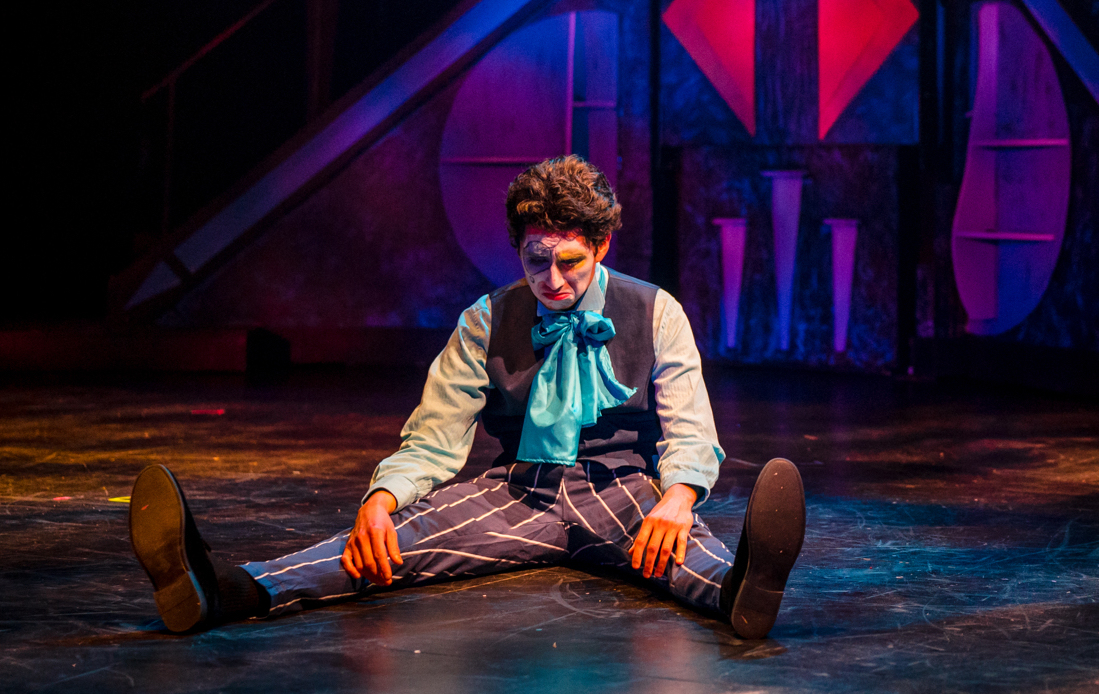Synetic Theater is renowned for performing plays without words, making their decision to adapt 18th century Italian playwright Carlo Goldini’s The Servant of Two Masters appear puzzling upon first glance. A complicated play with several major plot points conveyed to the audience through characters’ verbal recounting of events, it hardly seems the perfect candidate for an adaptation without any words. But, with an approach similar to the several Shakespearean plays executed over the years since their 2001 founding, Synetic does more than manage it: they exceed expectations. Telling the story through the theater’s usual blend of dance, acrobatics, and carefully crafted physicality, Synetic successfully transforms the centuries-old play into 90 minutes of enrapturing entertainment.
The play follows—what else—a servant, Truffaldino (Vato Tsikurishvili) as he navigates the complex social web into which he finds himself thrust. Truffaldino meets his first master, Beatrice (Nutsa Tediashvili), at the beginning of the play when she happens to run by the place where he sits in the street. As far as Truffaldino knows, however, Beatrice is not Beatrice at all, but Federigo, her deceased brother as whom she is disguised. The disguise is not one she’s used to, as she had donned it only a moment before, after she and her lover, who is accused of killing Federigo, were chased by the police. The two lovers had been separated from each other during the chase, leaving Beatrice on her own to navigate her new situation. The exaggerated masculine swagger as she, a relatively small woman, does her best to impersonate a man plays perfectly off of Truffaldino’s broad, comedic physicality, and this dynamic continues as the two establish a formal master/servant relationship.
Truffaldino and Beatrice make their way to a hotel run by Pantalone (Philip Fletcher), much to the chagrin of Pantalone’s daughter, Clarice (Irene Hamilton), who has been promised to Federigo by her father despite being in love with Silvio (Pablo Guillen). Clarice initially resists what she perceives as “Federigo”’s advances in a scene that flows so well with the background music that it more closely resembles a dance than a fight, until Beatrice reveals her true identity and tells Clarice her story. Beatrice’s transition from the somewhat sleazy masculine physicality of her disguise to that of a young woman confiding in a friend is stark, and it serves to differentiate her true self from her Federigo persona just as much as the removal of her fake mustache and hat.
And this hotel facilitates more than just the meeting between the two women; it also enables Truffaldino to pick up his second master, Florindo (Jacob Thompson). Florindo, who the audience recognizes as Beatrice’s lost lover, is tired after his flight from the police, an energy instantly contrasted with the harlequin persona of Truffaldino, whom he asks for directions to a place to stay. Truffaldino, eagerly spying the chance to earn more money, begins his time as Florindo’s servant by taking him to the hotel where he and Beatrice have been staying.
As the two lovers, both still searching for each other and unaware that they’re staying in the same hotel, settle in, Truffaldino struggles to keep both his masters satisfied without clueing either in on the fact that he’s working for two people, while at the same time developing a romantic relationship with the hotel’s maid, Smeraldina (Maryam Najafzada). From there, the bulk of the play’s runtime is a mix of slapstick hijinks and beautifully athletic physical expression typical of Synetic’s productions.
Though much has changed with the adaptation to wordless physical theater, the play’s commedia dell’arte roots shine through. The makeup and costume design, though expertly tailored to match the personality of each of this adaptation’s characters, manages to also pay clear homage to the aesthetics of commedia tradition, incorporating bright colors and exaggerated facial expressions into a performance that is unmistakably modeled after the Italian pantomime. The deliberate use of color—especially bold primary colors—in the costumes stands out especially well against the minimalistic but cleverly dynamic set, the modular and wheeled design of which allows for relatively few pieces to create a number of strikingly different tableaus.
The actors’ performances, too, beautifully balance Synetic’s unique spin on the characters with the traditional archetypes characteristic of 18th century Italian theater. Vato Tsikurishvili’s performance of the eponymous Truffaldino is especially notable for the skill, comedy, and athleticism with which he embodies commedia dell’arte’s iconic Harlequin stock character. The rest of the small cast is similarly talented, beautifully bringing their characters to life. With performances this strong, the synopsis included in the playbill is hardly needed, even without a single word being uttered on the stage.
From the funniest of slapstick sequences to the most touching of romance scenes, Synetic’s The Servant of Two Masters is a rousing success. A farce as compelling as it is hilarious, this one is a must-see for theater enthusiasts in the DC area.
Sparked by Synetic’s founders’ experience as immigrants from Soviet Georgia, donations for United Help Ukraine are collected after each performance, and a special performance of The Servant of Two Masters will be held on Friday, April 29 at 8pm benefitting the same group.





